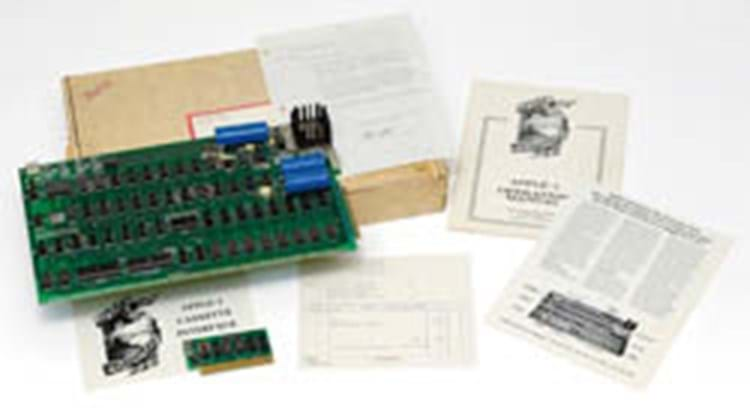
It was sold without any form of casing, and without a power supply, keyboard or monitor, but because the motherboard of the Apple I was completely pre-assembled, it was in effect the first personal computer and a major advance on their competitors' self-assembly kits - even with only 8K bytes of RAM.
It was, however, enormously expensive for the time at $666.66, and when a much more advanced Apple II was introduced in April of the following year - setting an engineering and development precedent for that now familiar rule that any new piece of kit you might order needs an update by the time it arrives - the price had dropped to $475.
Whilst a lot of development had taken place with the Apple II having an integrated keyboard, sound, a plastic case and eight internal expansion slots, hanging onto, and looking after, an Apple I could nevertheless have proved an excellent long-term investment, as an example offered as part of a Christie's book sale on November 23, clearly demonstrated.
At the time it was catalogued, Christie's had been unable to confirm just how many were made, but the book department's Julian Wilson was subsequently able to talk to Steve Wozniak, who told him that with a little help from Jobs and their girlfriends, he had assembled two batches of 100, of which around 150 were sold. The remainder, it seems, were either destroyed or cannibalised for parts.
The machine offered here, along with an Apple cassette interface (supplied at the time at an additional $75), was still in the original packaging, as delivered to Electric City Radio Supply of Great Falls, Montana. Complete with operation manual and other documentation bearing the original company logo of Newton sitting under an apple tree, it also came with a typed letter to a Frank Anderson (possibly the owner of ECRS) signed by Jobs, and the original invoice, identifying the salesman simply as Steven.
This example has, in fact, been fitted with a later microprocessor, but what makes this Apple I so much more valuable than all the others that survive is all that packaging and accompanying documentation.
Such things may not excite those in the vintage computer trading world, much of whose activity takes place on eBay, but this packaging, combined with Christie's marketing and targeting of a very different audience was crucial to its financial success.
Julian Wilson tells me that the wider vintage computer community seemed to have decided that $14,000 was the right price for an Apple I, and when this exceptional example was sold for $50,000 on eBay about a year ago, it was seen in those circles as grossly overpriced. How wrong they were to be proved.
At King Street last month this proto-personal computer package - not quite mint and boxed as issued, but very nearly so - was sold at £110,000 plus premium over the telephone to Marco Boglione, an Italian businessman who has built up a collection of early computers and, according to press reports, plans to open a Museum of Information Technology in Turin. Steve Wozniak was at the Christie's sale and offered to sign the Apple I.
By Ian McKay




